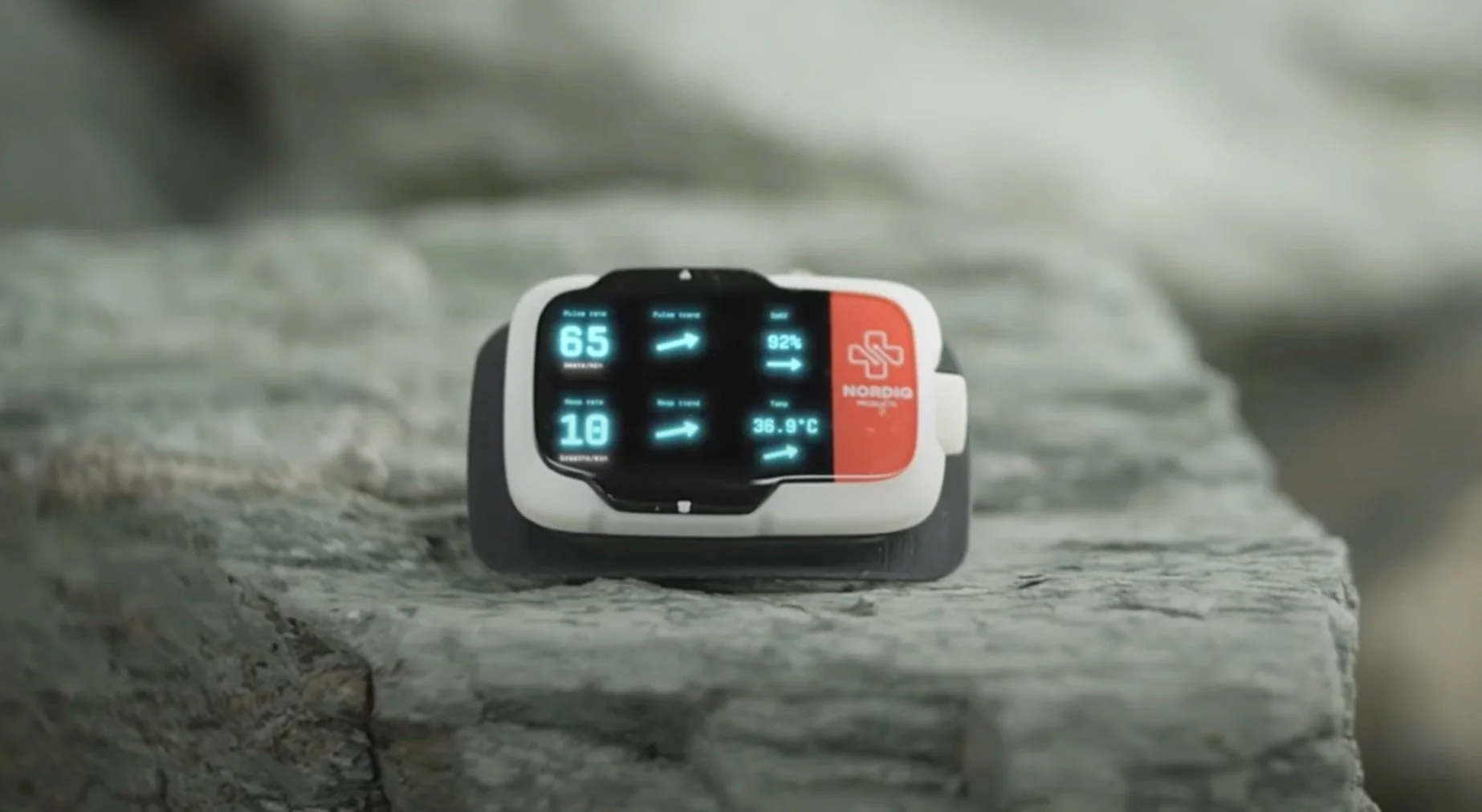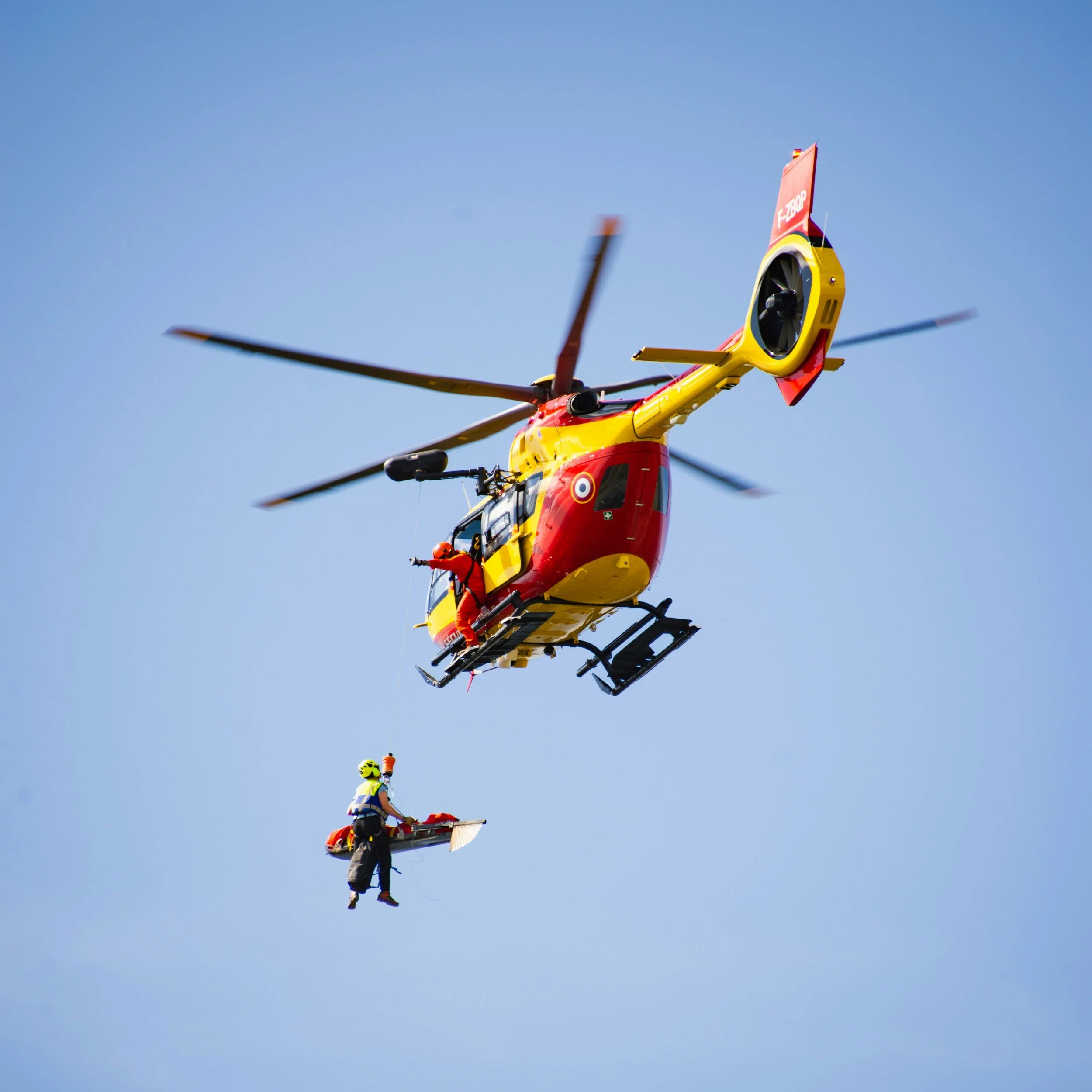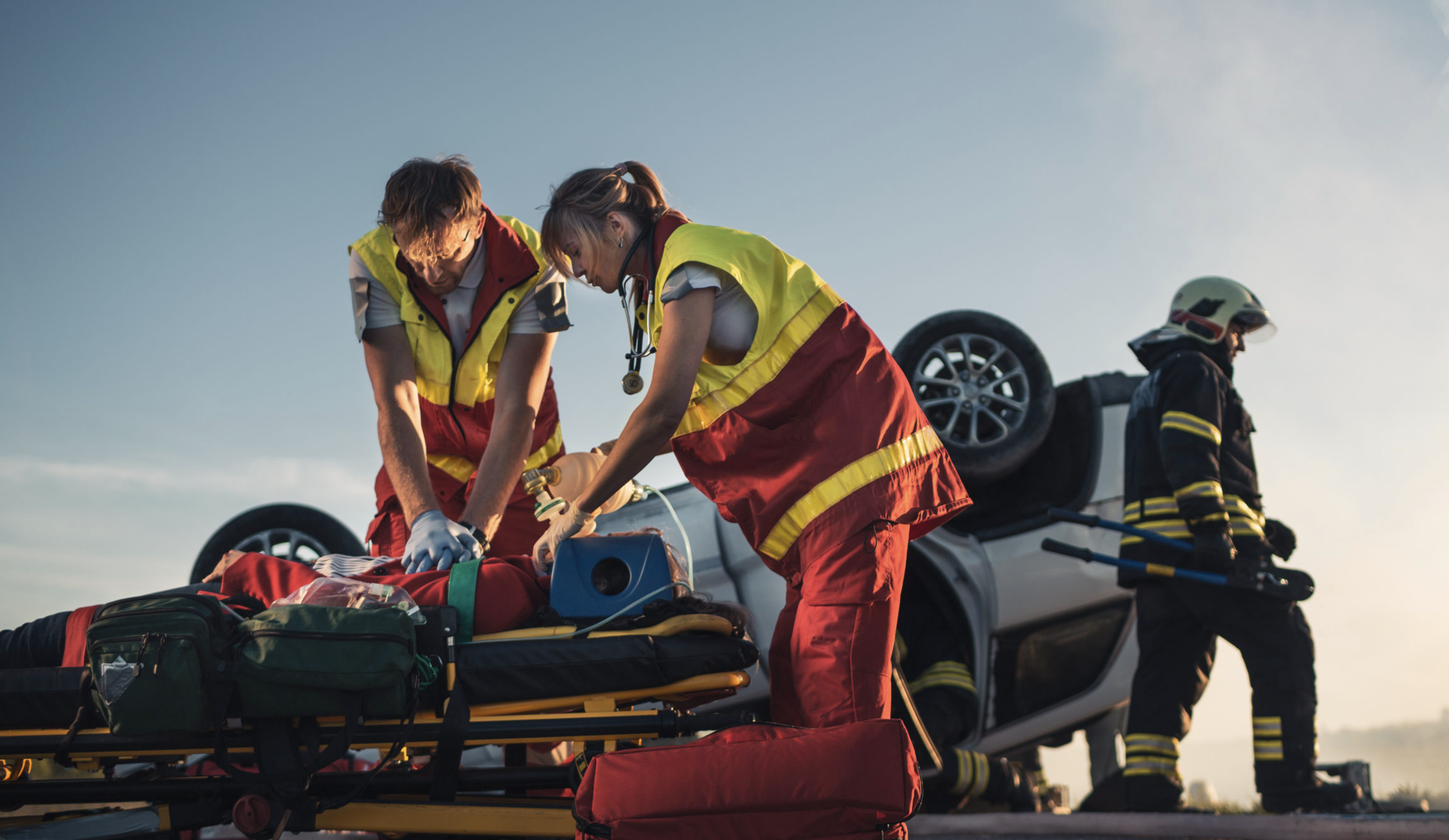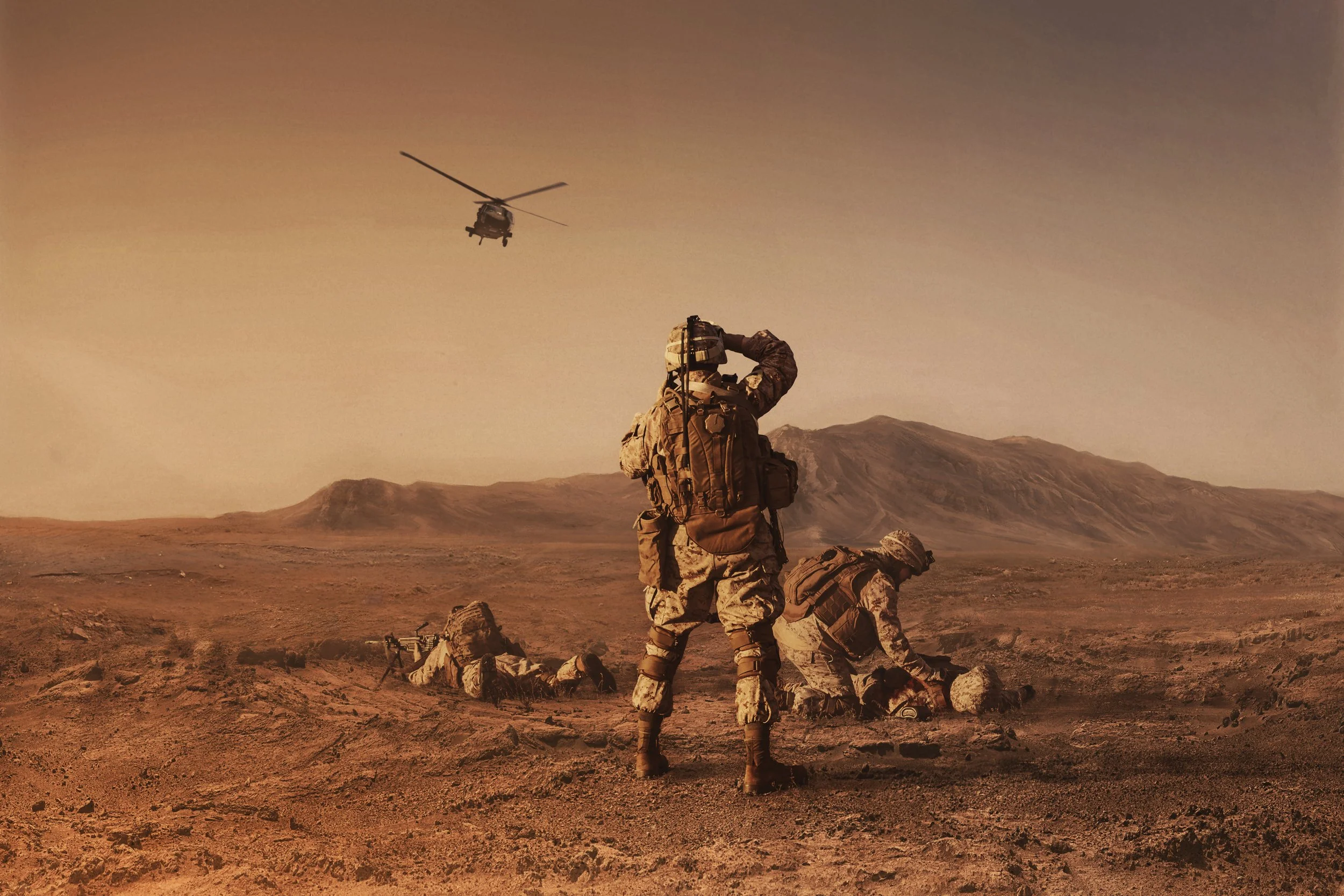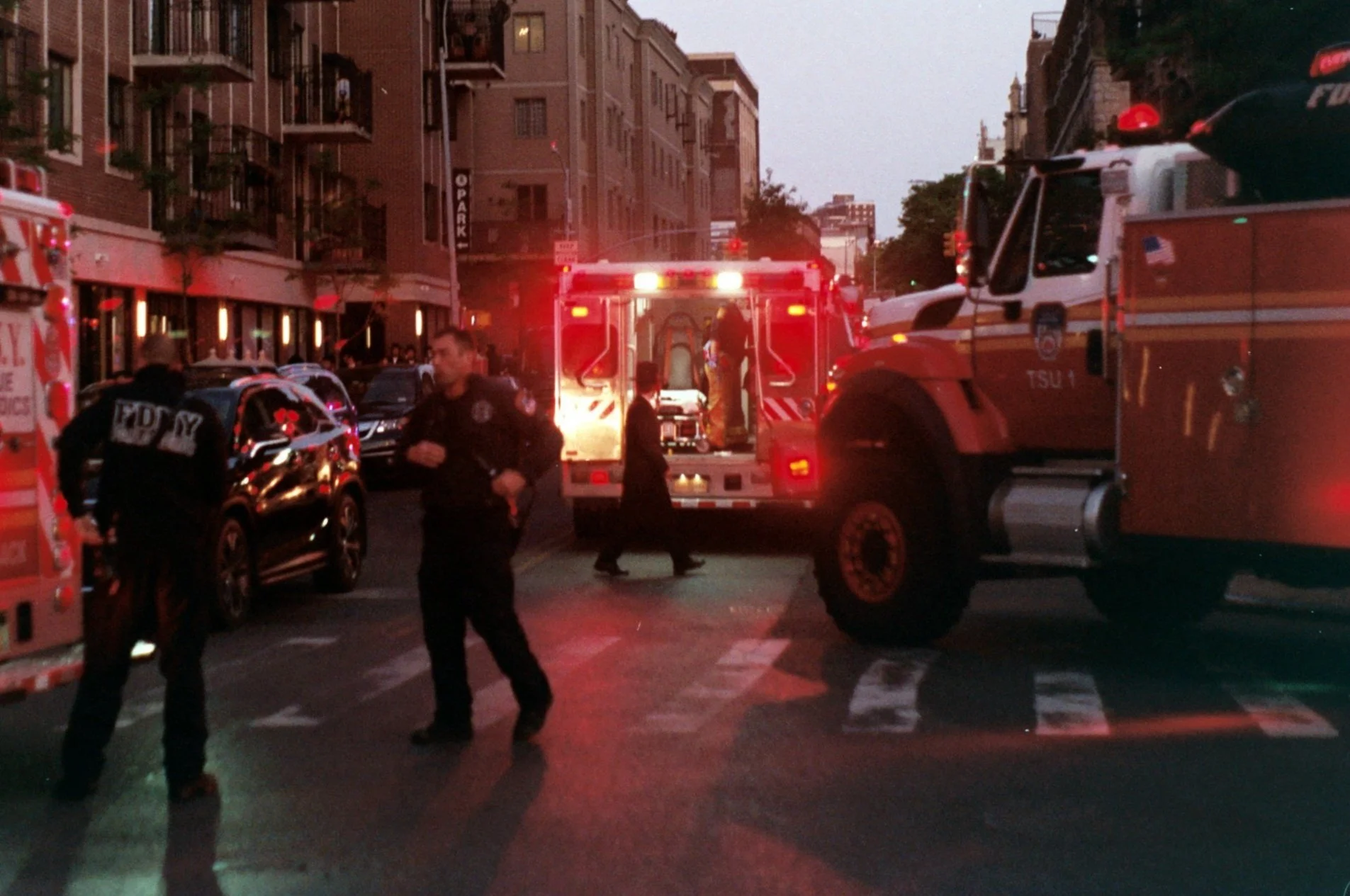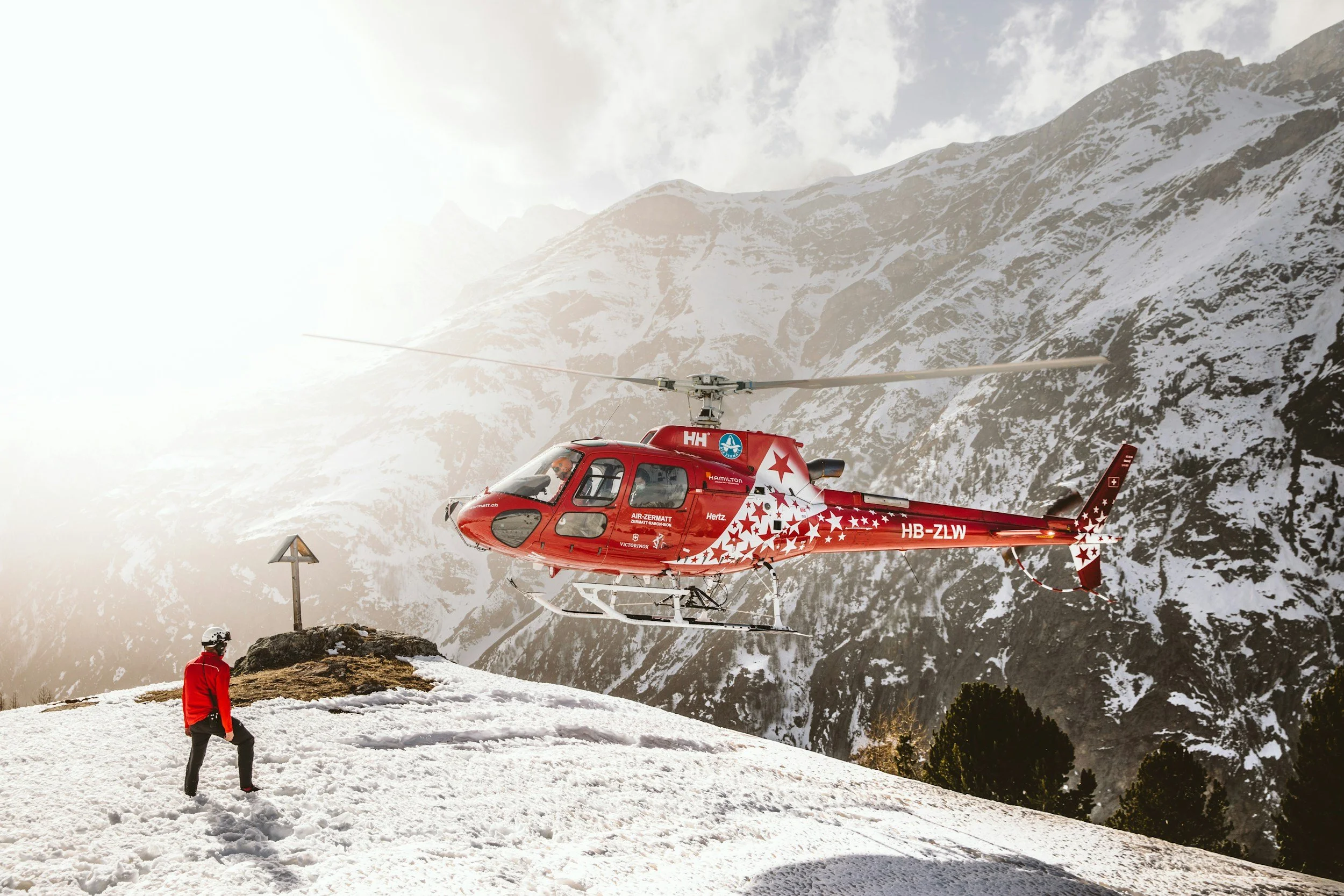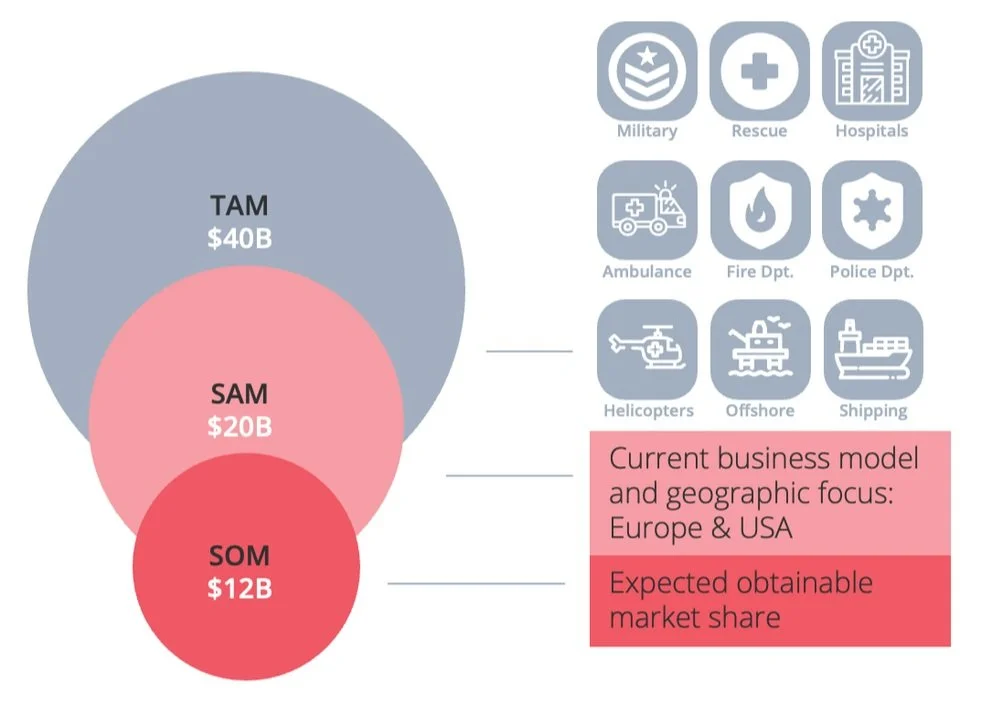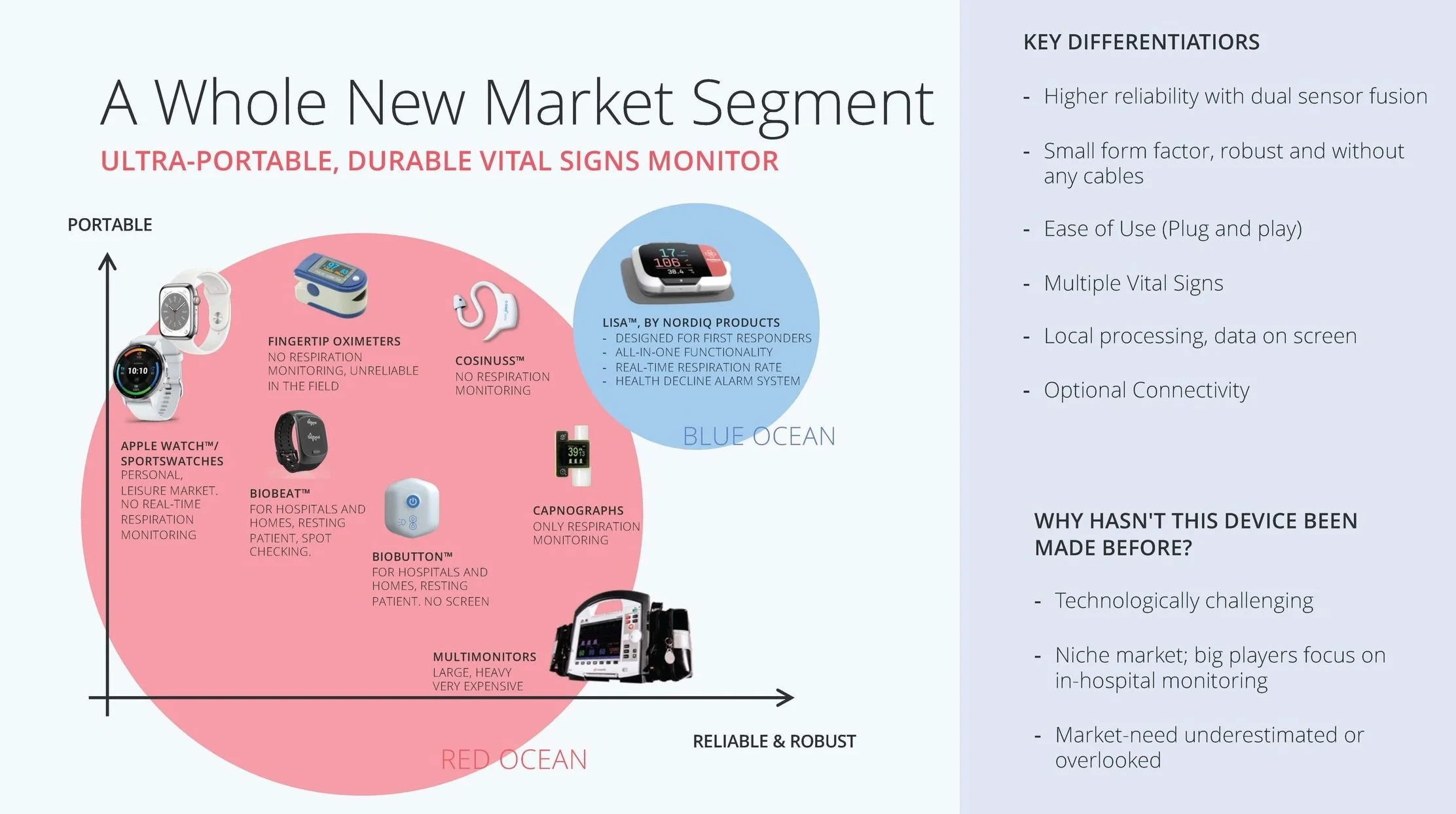Why invest?
A critical need in the field.
Today's emergency medical solutions lack reliability or ease of use and robustness for field use. Military medics and first responders often have to rely on manual observation, while existing sensors such as finger pulse oximeters are unreliable.
LiSa™ provides objective real-time data and alerts users to critical changes in the patient's condition.
We have collected some quotes from potential users of LiSa™ that demonstrate its potential in the market:
Market needs and validation of LiSa™ (PDF, Norwegian)
Market Pull and Validation of LiSa™ (PDF, English)
Strong technology, a competent team, and unique market position
Nordiq has developed its own patented and patent-pending sensor technology
LiSa ™ is patented.
The patent-pending LightSense ™ (optical sensor) and AcouSense ™ (acoustic sensor) technologies work together in sensor fusion and allow LiSa ™ to provide reliable measurements of pulse and respiration in demanding environments.
LiSa ™ itself provides an indication of the quality of the measurements it makes – something no other portable device offers today.Unique theoretical expertise
Nordiq Products has Norway's leading expertise in biomedical optics . Through inventor Lise Randeberg and our tech team, we have advanced and internationally recognized theoretical knowledge in the field, and we have specialized, in-depth understanding of how light behaves in skin tissue. This gives us a technological advantage that other pulse oximeter manufacturers do not necessarily possess.
The fact that the idea for LiSa™ comes from a first-hand military situation where lack of access to patient monitoring in the field led to loss of life is also one of the company's strengths.
This gives us a close and good understanding of both the problem in the market and the solution we offer.Low technological risk
Our sensor technology has now been developed and tested to the point that we know it works. It now remains to finalize the design of the patented product LiSa ™, and carry out the regulatory approval. We have a thoroughly prepared plan for this, but we need time and capital. If the need for capital is covered, we will have a fully designed working product in about 1 year, ready for the approval process and CE marking, and then industrialization and production. The plan is to have LiSa ™ on the market by 2028.
LiSa™ is patented and designed for field use, filling a gap in the market
Our patent for LiSa ™ was approved in February 2025, and will address a need for reliable patient monitoring in demanding environments.
No other patient monitor can be described as “Robust, compact, with no moving parts, and independent of external displays. Perfect for military and civilian rescue operations.”Sensible use of capital and an agile and efficient team
We have a track record of very efficient use of capital, and we have accomplished a great deal with relatively little. We have great respect for the investors' capital and the support we receive from the Research Council of Norway, and we do not waste it.
Real-time monitoring of breathing
The uniqueness of our technology is that LiSa ™ can measure breathing in real time. With a unique optical sensor we measure the breathing pattern via the blood flow, and with the acoustic sensor we also measure the sound of the breathing pattern directly through the throat. Together, this provides extremely useful input to the first responder, as breathing is an important indicator of the patient's status that is crucial to have control over, but which is something they usually have to see, listen and feel to monitor. LiSa ™ will deliver this and free up significant resources that can be used for life-saving treatment and transport of the patient.
Alarm
LiSa ™ will inform the user if the patient's condition worsens. Future versions of LiSa ™ are planned with the integration of machine learning and AI for early warning of worsening conditions using pattern recognition.
Placement on neck
The LiSa ™ placement on the neck is beneficial for providing reliable monitoring, as it provides safe access to blood flow (unlike finger-worn pulse oximeters), and close access to listen to the breathing apparatus. The neck is also easily accessible without having to remove clothing and increasing the risk of hypothermia. However, placement on the neck is not a requirement if it is impossible, as LiSa™ can also be placed in other locations and still provide good measurements.
Connectivity
LiSa™ can be connected to external displays and centralized systems for direct communication with e.g. emergency medical services or military command centers to provide direct information about the patient's condition. This can, for example, give specialists direct access to the situation and enable assistance, and it can give hospitals access to the course of the incident, which simplifies reception at the emergency room, improves diagnosis, and documents the patient's status from an earlier point of entry than today.
Overview of mass casualty situations
By using one LiSa ™ on each patient in a situation with multiple casualties, such as after a rocket attack in war, after a terrorist attack, or after a car accident, someone with few personnel present can still get a good overview of the status of all casualties. Each unit of LiSa ™ will report to an external screen, and the situation manager can prioritize help to those who need it most, and also be notified if re-prioritization is necessary because the situation suddenly changes for someone.
“Dual-Use” in a market with high willingness to pay
Can you put a price on a saved life?
The European defense needs major investments for upgrading and efficiency, and Nordiq Products is largely targeting the defense by delivering a solution tailored to their needs. We have developed LiSa ™ based on a personal experience in the defense, and in continuous dialogue and collaboration with medical personnel in the Norwegian defense.
But civilian first responders also need reliable and robust patient monitoring solutions that enable efficiency and automation of important processes. That's why we have also collaborated closely with, among others, the Red Cross to ensure that the solution meets their needs.
LiSa™ is therefore positioned for so-called dual-use , i.e. it is designed for both military and civilian use .
LiSa ™ will come in handy where a person is unconscious or seriously injured without access to hospital equipment.Unique skin type calibration – Precise measurements for everyone
LiSa™ utilizes our patent-pending SkinSight ™ algorithm, an advanced calibration algorithm that ensures accurate vital sign measurements regardless of skin type. Traditional pulse oximeters have reduced accuracy on individuals with darker skin, especially when measuring oxygen saturation (SpO2), but LightSense ™ automatically adjusts for individual differences in skin light absorption and reflection. This makes LiSa ™ the most reliable wearable solution for real-time monitoring, no matter who it is used on.
This unique quality of LightSense ™ means that our technology may have potential in products other than LiSa™, where reliable SpO2 measurement is desired on all skin types.Built-in display for easy accessibility and offline mode
Unlike e.g. SemPulse or Cosinus' C-Med Alpha, LiSa ™ does not require an external display or network. This is crucial in some military scenarios where electronic signatures can be revealing of the user's location. The built-in display also makes the product faster available and easier to use in an emergency situation where time is of the essence. Simply attach LiSa ™ to the neck in a simple maneuver and start life-saving work.
The civilian market – LiSa™ as a new standard for patient monitoring outside of the hospital
LiSa™ has enormous potential in the civilian market, where the need for continuous and reliable patient monitoring is increasing. Today's first aid routines are often based on subjective observation, and critical changes in breathing and pulse can go unnoticed. LiSa™ fills this gap by providing real-time measurements and automatic notification of life-threatening conditions.
Ambulances and Emergency Medicine – Provides real-time data on heart rate and respiration during transport outside the ambulance, allowing healthcare professionals to make faster and better decisions.
Rescue and Disaster Medicine – Ideal for search and rescue teams in demanding environments, where rapid triage and reliable monitoring can save lives.
Hospitals and intensive care units – Wireless and portable monitoring that relieves healthcare personnel and enables early warning of deterioration, especially when transporting patients within the hospital.
Home nursing and elderly care – Continuous monitoring of vulnerable patients outside of hospitals without the need for heavy, stationary equipment.
Public buildings and workplaces – Can be placed where defibrillators are available , and provide immediate access to advanced patient monitoring with direct contact and transmission of vital signs to emergency services and healthcare professionals before medical help arrives.
Sports facilities and events – Valuable in managing acute medical events, such as cardiac arrest, heatstroke, or injuries during sports and physical activities.
Transportation – Can be integrated into planes, trains, boats and buses , where access to medical personnel may be limited, and early warning and connectivity to emergency services and healthcare personnel can make a critical difference.
With its unique combination of precise monitoring, ease of use and flexible placement, LiSa™ could become a new standard for patient monitoring in the civilian market.
The military market – LiSa™ as a game-changer in field medicine
We have established strong links to the Norwegian Armed Forces and Special Forces, and we have contact with American Special Forces.
LiSa™ has been met with great interest from several actors within the defense industry.
In military operations, fast and accurate patient monitoring is essential to saving lives. LiSa™ is designed to provide paramedics and soldiers with a robust and reliable solution for automatic monitoring of vital signs in the field. Today's paramedics often rely on manual observation ("look, listen & feel"), which can be unreliable under stress and in chaotic situations. LiSa™ solves this problem by providing real-time measurements of pulse, oxygen saturation and respiratory rate, as well as automatic alerts in case of critical changes.
Medics in the field – Automatic notification of respiratory arrest or critical conditions ensures that life-saving measures are implemented quickly.
Mass evacuation and disaster management – Rapid triage and remote monitoring of multiple injured people simultaneously provides a better basis for decision-making in demanding situations.
Military Vehicles and Field Hospitals – Can be used during transport for real-time monitoring of injured soldiers, and integrated into field hospitals for continuous monitoring. LiSa™ has been tested onboard multiple forms of transport, such as helicopters, boats, ATVs, etc.
Tactical use – offline mode – LiSa™ can operate completely offline, without emitting electronic signals, which is crucial for operations where digital signatures can reveal positions .
Integration with command centers – Can be connected to centralized systems for real-time data transmission to military command centers and medical units, allowing life-saving measures to be coordinated effectively.
LiSa™ is designed to withstand the extreme demands of military operations and provides medical personnel and special forces with a new and crucial tool for life-saving efforts in the field.
Participation in the Arctic Warrior Experiment (TE25-1):
In January 2025, Nordiq Products was selected to participate in the Arctic Warrior Experiment (AWE) under the auspices of USSOCOM (US Special Forces), NORSOCOM (Norwegian Special Forces) and the Norwegian Defence Research Institute (FFI).
The fact that Nordiq was selected to participate in AWE shows military interest in our technology and it confirms that LiSa ™ is a desired product that is tailored for use in extreme conditions.
Usage examples for LiSa™
Example #1: Remote first aid (Red Cross, military paramedics, etc.)
Built for continuous use – a wearable device that can accurately monitor vital signs and send data to a cloud solution or feed other health data systems with vital signs information.
Example #2: Mass casualty events
Imagine a bus accident or an explosion at an industrial or construction site. Multiple injured – some conscious and in shock, some screaming for help, and some unconscious. It requires extensive prioritization, and you will always lack enough personnel in such a situation.
Example #3: Surveillance during first aid (Police, Fire and Rescue, Ambulance)
As the first professional emergency responder on the scene of an accident, you must remain calm, secure the area, report the incident, and begin treatment for the patient(s). Keeping track of vital signs requires you to check and recheck them regularly. This is time-consuming and only provides snapshots – not the trend or the full picture.
Significant market size
Total addressable market (TAM) if Nordiq achieved 100% market share in the segment (not including recurring sales).
Competition and differentiation
Compared to existing solutions on the market, LiSa™ offers several decisive advantages:
LiSa™ is the only solution that offers continuous respiratory measurement and airway quality assessment in a portable form factor, while operating completely offline with a built-in display.
LiSa™ also has the option of connectivity to external displays and centralized systems such as nearby hospitals, emergency medical centers (113/911) or command centers.
LiSa™'s location on the neck gives it access to skin that stays warm in cold environments to a much greater extent than, for example, fingers. This will provide greater reliability to the measurements, as good blood supply to the skin is a necessity for good monitoring.
Here you can see our pitch deck for a short presentation of the project:
pitchdeck.nordiqproducts.com

